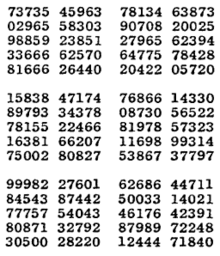A Million Random Digits with 100,000 Normal Deviates

A Million Random Digits with 100,000 Normal Deviates is a 1955 random number book by the RAND Corporation. The book, consisting primarily of a random number table, was an important 20th century work in the field of statistics and random numbers. It was produced starting in 1947 by an electronic simulation of a roulette wheel attached to a computer, the results of which were then carefully filtered and tested before being used to generate the table. The RAND table was an important breakthrough in delivering random numbers, because such a large and carefully prepared table had never before been available. In addition to being available in book form, one could also order the digits on a series of punched cards. The main use of the tables was in statistics and the experimental design of scientific experiments, especially those that used the Monte Carlo method; in cryptography, they have also been used as nothing up my sleeve numbers, for example in the design of the Khafre cipher. The book was one of the last of a series of random number tables produced from the mid-1920s through the 1950s, after which the development of high-speed computers allowed faster operation through the generation of pseudorandom numbers rather than reading them from tables.
The book was reissued in 2001 (ISBN 0-8330-3047-7) with a new foreword by RAND Executive Vice President Michael D. Rich. It has generated many humorous user reviews on Amazon.com.[1][2]
The digits begin:
Notes
- ↑ Amazon.com Customer Reviews: A Million Random Digits with 100,000 Normal Deviates (Paperback version)
- ↑ Heffernan, Virginia (January 15, 2010). "The Reviewing Stand". The New York Times Magazine. Retrieved 2011-03-09.
References
- George W. Brown, "History of RAND's random digits—Summary," in A.S. Householder, G.E. Forsythe, and H.H. Germond, eds., Monte Carlo Method, National Bureau of Standards Applied Mathematics Series, 12 (Washington, D.C.: U.S. Government Printing Office, 1951): 31-32. (Available here for download from the RAND Corporation.)